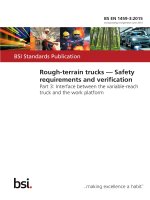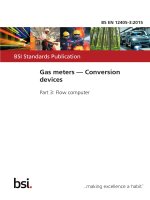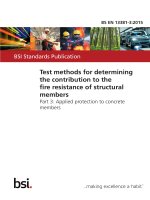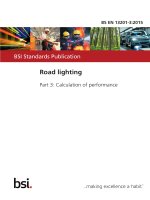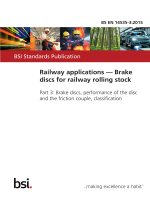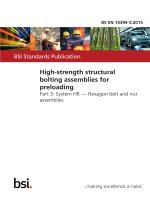Bsi bs en 62379 3 2015
Bạn đang xem bản rút gọn của tài liệu. Xem và tải ngay bản đầy đủ của tài liệu tại đây (1.78 MB, 72 trang )
BS EN 62379-3:2015
BSI Standards Publication
Common control interface
for networked digital audio
and video products
Part 3: Video
BRITISH STANDARD
BS EN 62379-3:2015
National foreword
This British Standard is the UK implementation of EN 62379-3:2015.
It is identical to IEC 62379-3:2015.
The UK participation in its preparation was entrusted to Technical
Committee EPL/100, Audio, video and multimedia systems and equipment.
A list of organizations represented on this committee can be obtained on
request to its secretary.
This publication does not purport to include all the necessary provisions of
a contract. Users are responsible for its correct application.
© The British Standards Institution 2015.
Published by BSI Standards Limited 2015
ISBN 978 0 580 81635 2
ICS 33.160; 35.100
Compliance with a British Standard cannot confer immunity from
legal obligations.
This British Standard was published under the authority of the
Standards Policy and Strategy Committee on 30 September 2015.
Amendments/corrigenda issued since publication
Date
Text affected
BS EN 62379-3:2015
EUROPEAN STANDARD
EN 62379-3
NORME EUROPÉENNE
EUROPÄISCHE NORM
September 2015
ICS 33.160; 35.100
English Version
Common control interface for networked digital audio and video
products - Part 3: Video
(IEC 62379-3:2015)
Interface de commande commune destiné aux produits
audio et vidéo numériques connectés en réseau Partie 3: Vidéo
(IEC 62379-3:2015)
Gemeinsame Steuerschnittstelle für netzwerkbetriebene
digitale Audio- und Videogeräte - Teil 3: Video
(IEC 62379-3:2015)
This European Standard was approved by CENELEC on 2015-07-10. CENELEC members are bound to comply with the CEN/CENELEC
Internal Regulations which stipulate the conditions for giving this European Standard the status of a national standard without any alteration.
Up-to-date lists and bibliographical references concerning such national standards may be obtained on application to the CEN-CENELEC
Management Centre or to any CENELEC member.
This European Standard exists in three official versions (English, French, German). A version in any other language made by translation
under the responsibility of a CENELEC member into its own language and notified to the CEN-CENELEC Management Centre has the
same status as the official versions.
CENELEC members are the national electrotechnical committees of Austria, Belgium, Bulgaria, Croatia, Cyprus, the Czech Republic,
Denmark, Estonia, Finland, Former Yugoslav Republic of Macedonia, France, Germany, Greece, Hungary, Iceland, Ireland, Italy, Latvia,
Lithuania, Luxembourg, Malta, the Netherlands, Norway, Poland, Portugal, Romania, Slovakia, Slovenia, Spain, Sweden, Switzerland,
Turkey and the United Kingdom.
European Committee for Electrotechnical Standardization
Comité Européen de Normalisation Electrotechnique
Europäisches Komitee für Elektrotechnische Normung
CEN-CENELEC Management Centre: Avenue Marnix 17, B-1000 Brussels
© 2015 CENELEC All rights of exploitation in any form and by any means reserved worldwide for CENELEC Members.
Ref. No. EN 62379-3:2015 E
BS EN 62379-3:2015
EN 62379-3:2015
European foreword
The text of document 100/2465/FDIS, future edition 1 of IEC 62379-3, prepared by Technical
Area 4 "Digital system interfaces and protocols" of IEC/TC 100 "Audio, video and multimedia systems
and equipment" was submitted to the IEC-CENELEC parallel vote and approved by CENELEC as
EN 62379-3:2015.
The following dates are fixed:
•
latest date by which the document has to be
implemented at national level by
publication of an identical national
standard or by endorsement
(dop)
2016-04-10
•
latest date by which the national
standards conflicting with the
document have to be withdrawn
(dow)
2018-07-10
Attention is drawn to the possibility that some of the elements of this document may be the subject of
patent rights. CENELEC [and/or CEN] shall not be held responsible for identifying any or all such
patent rights.
Endorsement notice
The text of the International Standard IEC 62379-3:2015 was approved by CENELEC as a European
Standard without any modification.
In the official version, for Bibliography, the following notes have to be added for the standards indicated:
2
IEC 62379-2:2008
NOTE
Harmonized as EN 62379-2:2009 (not modified).
IEC 62379-5 Series
NOTE
Harmonized as EN 62379-5 Series.
IEC 62379-7
NOTE
Harmonized as EN 62379-7.
BS EN 62379-3:2015
EN 62379-3:2015
Annex ZA
(normative)
Normative references to international publications
with their corresponding European publications
The following documents, in whole or in part, are normatively referenced in this document and are
indispensable for its application. For dated references, only the edition cited applies. For undated
references, the latest edition of the referenced document (including any amendments) applies.
NOTE 1 When an International Publication has been modified by common modifications, indicated by (mod), the relevant
EN/HD applies.
NOTE 2 Up-to-date information on the latest versions of the European Standards listed in this annex is available here:
www.cenelec.eu
Publication
Year
Title
EN/HD
Year
IEC 62379-1
2007
Common control interface for networked
digital audio and video products Part 1: General
EN 62379-1
2007
3
–2–
BS EN 62379-3:2015
IEC 62379-3:2015 © IEC 2015
CONTENTS
FOREWORD ......................................................................................................................... 4
INTRODUCTION ................................................................................................................... 6
1
Scope ............................................................................................................................ 7
2
Normative references..................................................................................................... 7
3
Terms, definitions and abbreviations .............................................................................. 7
3.1
Terms and definitions ............................................................................................ 7
3.2
Abbreviations ........................................................................................................ 7
4
Video format definitions ................................................................................................. 7
4.1
Video signal format definitions ............................................................................... 7
4.1.1
General ......................................................................................................... 7
4.1.2
Video parameters ........................................................................................... 7
4.1.3
Video signal formats ...................................................................................... 9
4.2
Video transport format definitions ........................................................................ 10
4.2.1
General ....................................................................................................... 10
4.2.2
Video transport root location......................................................................... 10
4.3
Video metadata format definitions ........................................................................ 10
4.3.1
General ....................................................................................................... 10
4.3.2
Video metadata root location ........................................................................ 10
5
MIB definitions for video blocks .................................................................................... 11
5.1
General ............................................................................................................... 11
5.2
Type definitions ................................................................................................... 11
5.2.1
General ....................................................................................................... 11
5.2.2
Textual conventions ..................................................................................... 11
5.2.3
Sequences ................................................................................................... 11
5.3
Video port and associated managed object type definitions .................................. 12
5.3.1
Generic port functionality ............................................................................. 12
5.3.2
Video locked to reference ............................................................................. 13
5.4
Other video block and associated managed object type definitions ....................... 14
5.4.1
Video mixer blocks ....................................................................................... 14
5.4.2
Video crosspoint blocks ................................................................................ 16
5.4.3
Video converter blocks ................................................................................. 18
5.4.4
Video level alarm blocks ............................................................................... 19
Annex A (informative) Machine-readable video format definitions ........................................ 22
Annex B (informative) Machine-readable video block definitions .......................................... 48
Annex C (informative) Tree of example video formats ......................................................... 61
Annex D (informative) Worked examples ............................................................................ 64
Bibliography ....................................................................................................................... 65
Figure 1 – Video port blocks ................................................................................................ 12
Figure 2 – Video mixer block ............................................................................................... 14
Figure 3 – Video crosspoint block ........................................................................................ 16
Figure 4 – Video converter block ......................................................................................... 18
Figure 5 – Video level alarm block ....................................................................................... 19
BS EN 62379-3:2015
IEC 62379-3:2015 © IEC 2015
–3–
Table 1 – Managed objects for video ports .......................................................................... 13
Table 2 – Managed objects for video locked ........................................................................ 13
Table 3 – Managed objects for video mixer blocks ............................................................... 14
Table 4 – Managed objects for video crosspoint blocks ........................................................ 17
Table 5 – Managed objects for video converter blocks ......................................................... 18
Table 6 – Managed objects for video level alarm blocks ....................................................... 20
BS EN 62379-3:2015
IEC 62379-3:2015 © IEC 2015
–4–
INTERNATIONAL ELECTROTECHNICAL COMMISSION
____________
COMMON CONTROL INTERFACE FOR NETWORKED
DIGITAL AUDIO AND VIDEO PRODUCTS –
Part 3: Video
FOREWORD
1) The International Electrotechnical Commission (IEC) is a worldwide organization for standardization comprising
all national electrotechnical committees (IEC National Committees). The object of IEC is to promote
international co-operation on all questions concerning standardization in the electrical and electronic fields. To
this end and in addition to other activities, IEC publishes International Standards, Technical Specifications,
Technical Reports, Publicly Available Specifications (PAS) and Guides (hereafter referred to as “IEC
Publication(s)”). Their preparation is entrusted to technical committees; any IEC National Committee interested
in the subject dealt with may participate in this preparatory work. International, governmental and nongovernmental organizations liaising with the IEC also participate in this preparation. IEC collaborates closely
with the International Organization for Standardization (ISO) in accordance with conditions determined by
agreement between the two organizations.
2) The formal decisions or agreements of IEC on technical matters express, as nearly as possible, an international
consensus of opinion on the relevant subjects since each technical committee has representation from all
interested IEC National Committees.
3) IEC Publications have the form of recommendations for international use and are accepted by IEC National
Committees in that sense. While all reasonable efforts are made to ensure that the technical content of IEC
Publications is accurate, IEC cannot be held responsible for the way in which they are used or for any
misinterpretation by any end user.
4) In order to promote international uniformity, IEC National Committees undertake to apply IEC Publications
transparently to the maximum extent possible in their national and regional publications. Any divergence
between any IEC Publication and the corresponding national or regional publication shall be clearly indicated in
the latter.
5) IEC itself does not provide any attestation of conformity. Independent certification bodies provide conformity
assessment services and, in some areas, access to IEC marks of conformity. IEC is not responsible for any
services carried out by independent certification bodies.
6) All users should ensure that they have the latest edition of this publication.
7) No liability shall attach to IEC or its directors, employees, servants or agents including individual experts and
members of its technical committees and IEC National Committees for any personal injury, property damage or
other damage of any nature whatsoever, whether direct or indirect, or for costs (including legal fees) and
expenses arising out of the publication, use of, or reliance upon, this IEC Publication or any other IEC
Publications.
8) Attention is drawn to the Normative references cited in this publication. Use of the referenced publications is
indispensable for the correct application of this publication.
9) Attention is drawn to the possibility that some of the elements of this IEC Publication may be the subject of
patent rights. IEC shall not be held responsible for identifying any or all such patent rights.
International Standard IEC 62379-3 has been prepared by technical area 4: Digital system
interfaces and protocols of IEC technical committee 100: Audio, video and multimedia
systems and equipment.
The text of this standard is based on the following documents:
FDIS
Report on voting
100/2465/FDIS
100/2495/RVD
Full information on the voting for the approval of this standard can be found in the report on
voting indicated in the above table.
This publication has been drafted in accordance with the ISO/IEC Directives, Part 2.
A list of all parts in the IEC 62379 series, published under the general title Common control
interface for networked digital audio and video products, can be found on the IEC website.
BS EN 62379-3:2015
IEC 62379-3:2015 © IEC 2015
–5–
The committee has decided that the contents of this publication will remain unchanged until
the stability date indicated on the IEC website under "" in the data
related to the specific publication. At this date, the publication will be
•
reconfirmed,
•
withdrawn,
•
replaced by a revised edition, or
•
amended.
A bilingual version of this publication may be issued at a later date.
–6–
BS EN 62379-3:2015
IEC 62379-3:2015 © IEC 2015
INTRODUCTION
The IEC 62379 series specifies the common control interface, a protocol for managing
equipment which conveys audio and/or video across digital networks.
The following parts exist or are planned:
1) General
2) Audio
3) Video
4) Data
5) Transmission over networks
6) Packet transfer service
7) Measurement for EBU ECN-IPM
IEC 62379-1:2007, specifies aspects which are common to all equipment, and it includes an
introduction to the common control interface.
IEC 62379-2:2008, IEC 62379-3 (this standard) and IEC 62379-4 (under consideration)
specify control of internal functions specific to equipment carrying particular types of live
media. IEC 62379-4 refers to time-critical data such as commands to automation equipment,
but not to packet data such as the control messages themselves.
IEC 62379-5 specifies control of transmission of these media over each individual network
technology. It includes network specific management interfaces along with network specific
control elements that integrate into the control framework.
IEC 62379-5-1 specifies management of aspects which are common to all network
technologies.
IEC 62379-5-2 specifies protocols which can be used between networking equipment to
enable the setting up of calls which are routed across different networking technologies.
IEC 62379-5-3, onwards, specify management of aspects which are particular to individual
networking technologies.
IEC 62379-6, specifies carriage of control and status messages and non-audiovisual data
over transports that do not support audio and video, such as RS232 serial links, with (as for
IEC 62379-5) a separate subpart for each technology.
IEC 62379-7 specifies aspects that are specific to the measurement of the service
experienced by audio and video streams and in particular to the requirements of EBU ECNIPM Measurements Group.
BS EN 62379-3:2015
IEC 62379-3:2015 © IEC 2015
–7–
COMMON CONTROL INTERFACE FOR NETWORKED
DIGITAL AUDIO AND VIDEO PRODUCTS –
Part 3: Video
1
Scope
This part of IEC 62379 details aspects of the common control interface specified in
IEC 62379-1 that are specific to video.
2
Normative references
The following documents, in whole or in part, are normatively referenced in this document and
are indispensable for its application. For dated references, only the edition cited applies. For
undated references, the latest edition of the referenced document (including any
amendments) applies.
IEC 62379-1:2007,
Part 1: General
3
Common control interface for networked audio and video products –
Terms, definitions and abbreviations
3.1
Terms and definitions
For the purposes of this document, the terms and definitions given in IEC 62379-1 apply.
3.2
Abbreviations
EBU ECN-IPM
European Broadcasting Union Expert Community
Infrastructure Internet Protocol Measurement
HD
High Definition
OID
Object Identifier
PSF
Progressive Segmented Frame
SD
Standard Definition
UHD
Ultra High Definition
4
Network
and
Video format definitions
4.1
Video signal format definitions
4.1.1
General
At any point in the video signal chain, the video data will be in a particular format. For
management purposes, the format shall be identified by an object identifier, either a “Common
control interface standard” object identifier as defined in this standard or an object identifier
defined elsewhere.
NOTE Permitting video format identifiers to be defined outside this standard allows use of proprietary formats
within the standard protocol and also allows industry standard formats to emerge that may eventually be
incorporated into future revisions of this standard.
4.1.2
4.1.2.1
Video parameters
General
The definitions in 4.1.3 make reference to "parameters" which provide additional information
about the format. These parameters shall be mapped to "sub-identifier" values as specified in
the other subclauses of 4.1.2. Any parameter may be "unspecified".
The "sub-identifier" values shall be appended to the object identifiers as additional arcs, in the
order in which the parameters are listed in the relevant subclause of 4.1.3; except that if a
–8–
BS EN 62379-3:2015
IEC 62379-3:2015 © IEC 2015
parameter is unspecified, and either is the last parameter or all subsequent parameters are
also unspecified, then it shall be omitted.
For all parameters, "unspecified" is coded as zero, so this rule ensures that the OID does not
end with a zero arc.
EXAMPLE If the last two parameters are vertical resolution and scan type, then 1080P would be coded as .1080.1,
1080P (with scan type unspecified) as .1080, and P (with vertical resolution unspecified) as .0.1.
4.1.2.2
Frame rate
The sub-identifier for frame rate shall be a value of the following type:
FrameRate::= Unsigned32 (0.. 2147483647)
-- An integer representing the calculated frame rate ratio of the encoded
-- video signal.
-- A value of zero shall indicate unspecified.
-- This is computed by calculating the frame rate ratio,
-- such as 24000/1001 = 23.976Hz and multiplying by 1000
-- to convert the value to an integer; in this case 23976.
-- For display purposes the value needs to be divided by
-- 1000 and a decimal point inserted as shown in the
-- Display-Hint.
4.1.2.3
Source type
The sub-identifier for the source type of the video shall be a value of the following type:
SourceType::= INTEGER {
unspecified (0),
sd
(1),
hd
(2),
uhd4k
(3),
uhd8k
(4)
} (unspecified.. uhd8k)
-- An integer representing the source type of the encoded video signal.
-- A value of zero shall indicate unspecified.
4.1.2.4
Vertical resolution
The sub-identifier for the vertical resolution shall be a value of the following type:
LineResolution::= INTEGER
-- An integer representing the vertical
-- resolution of the encoded video signal.
-- A value of zero shall indicate unspecified.
4.1.2.5
Scan type
The sub-identifier for the video scan type shall be a value of the following type:
ScanType::= INTEGER {
unspecified (0),
progressive (1),
interlaced
(2),
psf
(3)
} (unspecified..psf)
-- An integer representing the scan type of the encoded video signal.
-- A value of zero shall indicate unspecified.
4.1.2.6
Coding type
The sub-identifier for the video coding type shall be a value of the following type:
CodingType::= INTEGER {
BS EN 62379-3:2015
IEC 62379-3:2015 © IEC 2015
–9–
unspecified
(0),
uncompressed (1),
mpeg2
(2),
h264
(3),
jpeg2000
(4),
smptevc2
(5),
vp8
(6),
h264ScaleExtn (7),
h265HEVC
(8)
} (unspecified.. h265HEVC)
-- An integer representing the coding type of the encoded video signal.
-- A value of zero shall indicate unspecified.
4.1.2.7
Source aspect ratio
The sub-identifier for the source aspect ratio shall be a value of the following type:
SourceAspectRatio::= INTEGER {
Unspecified
(0),
fourByThree
(43),
sixteenByNine (169),
twoPointTwoOne (221)
} (unspecified..twoPointTwoOne)
-- An integer representing the source aspect ratio of the encoded
-- video signal.
-- A value of zero shall indicate unspecified.
4.1.2.8
Active format description codes
The sub-identifier for the active format description codes shall be a value of the following type:
ActiveFormatDescriptionCodes::= INTEGER
-- An integer representing the active format description codes for
-- video used with the range of source aspect ratios.
-- The codes are from 0000-1111
-- See SMPTE ST 2016-1:2009 for code descriptions.
4.1.3
Video signal formats
4.1.3.1
Video signal format root location
Video signal formats shall be rooted at the following location in the MIB tree:
iec62379
OBJECT IDENTIFIER::= { iso(1) standard(0) 62379 }
videoFormat
OBJECT IDENTIFIER::= { iec62379 video(3) format(2) }
videoSignalFormat
OBJECT IDENTIFIER::= { videoFormat Signal(1) }
The following definitions shall be used to identify the specified formats.
NOTE
Annex C contains an example of set of formats defined by this standard.
4.1.3.2
Unspecified video
unspecifiedVideo
OBJECT IDENTIFIER::=
{ videoSignalFormat unspecified(0) }
-- wildcard – any supported format allowed
4.1.3.3
No video
noVideo
OBJECT IDENTIFIER::= { videoSignalFormat none(1) }
-- indicates the output is non-existent
4.1.3.4
Invalid video
invalidVideo
OBJECT IDENTIFIER::= { videoSignalFormat invalid(2) }
– 10 –
BS EN 62379-3:2015
IEC 62379-3:2015 © IEC 2015
-- indicates an error, such as inability to decode a signal earlier in
-- the chain
4.1.3.5
Video source
videoSource
-- video source
OBJECT IDENTIFIER::= { videoSignalFormat source(3) }
The video source identifier shall have four parameters. The first shall be the frame rate, the
second shall be the video source type, the third shall be the vertical resolution and the fourth
shall be the scan type.
4.1.3.6
Video coding type
videoCodingType
OBJECT IDENTIFIER::= { videoSignalFormat coding(4) }
-- video coding type
The video coding type identifier shall have one parameter. This shall be either the coding type
or uncompressed, if not coded.
4.1.3.7
Aspect ratio
aspectRatio
OBJECT IDENTIFIER::=
-- aspect ratio of the video
{ videoSignalFormat aspectRatio (5) }
The video aspect ratio identifier shall have two parameters. The first shall be the source
aspect ratio, the second shall be the active format description code for the source aspect ratio.
4.2
Video transport format definitions
4.2.1
General
For management purposes, the transport format shall be identified by an object identifier,
either a “Common control interface standard” object identifier as defined in this standard or an
object identifier defined elsewhere.
NOTE Permitting video transport format identifiers to be defined outside this standard allows use of proprietary
formats within the standard protocol and also allows industry standard formats to emerge that may eventually be
incorporated into future revisions of this standard.
4.2.2
Video transport root location
Video transport formats shall be rooted at the following location in the MIB tree:
videoTransportFormat OBJECT IDENTIFIER::= { videoFormat transport(2) }
The following definitions shall be used to identify the specified transport formats.
unspecifiedTransport OBJECT IDENTIFIER::=
{ videoTransportFormat unspecified(0) }
analogue
4.3
4.3.1
OBJECT IDENTIFIER::= { videoTransportFormat analogue(1) }
Video metadata format definitions
General
For management purposes, the metadata format shall be identified by an object identifier,
either a “Common control interface standard” object identifier as defined in this standard or an
object identifier defined elsewhere.
NOTE Permitting video metadata format identifiers to be defined outside this standard allows use of proprietary
formats within the standard protocol and also allows industry standard formats to emerge that may eventually be
incorporated into future revisions of this standard.
4.3.2
Video metadata root location
Video metadata formats shall be rooted at the following location in the MIB tree:
videoMetadataFormat
OBJECT IDENTIFIER::= { videoFormat metadata(3) }
BS EN 62379-3:2015
IEC 62379-3:2015 © IEC 2015
– 11 –
The following definitions shall be used to identify the specified metadata formats.
unspecifiedMetadata
5
OBJECT IDENTIFIER::=
{ videoMetadataFormat unspecified(0) }
MIB definitions for video blocks
5.1
General
This clause defines a set of managed object types for representing control functions in
network controlled video equipment. The format of the definitions is as specified in
IEC 62379-1.
For management purposes, a piece of video equipment shall be modelled as a number of
discrete video blocks and video connectors, as specified in IEC 62379-1. Each video block
may have zero or more inputs and zero or more outputs, and each input or output may carry
one or more channels. Each video connector shall connect one video block output to one
video block input with a one-to-one mapping of channels between the blocks.
NOTE 1 A piece of equipment may be fixed-function, in which case the number of video blocks present and the
connections between them will be immutable, or it may be programmable, in which case the number of video blocks
present and/or the connections between them may be changed by the user.
Each video block shall be modelled either by one of the standard video block types defined in
this standard or by a video block type defined elsewhere. Associated with each defined block
type shall be a (possibly empty) group of managed object types that represent the control
functions for that block. A block type shall be identified by the node in the object identifier tree
that is the root node for the group of managed object types associated with that block type.
NOTE 2 Permitting video block types to be defined outside this standard allows control of proprietary functions
using the standard protocol and also allows industry standard block types to emerge that may eventually be
incorporated into future revisions of this standard.
NOTE 3 An empty group of managed object types is permitted to allow for blocks that have no associated control
functions.
NOTE 4
5.2
5.2.1
Annex D contains worked examples of the block structure.
Type definitions
General
In addition to the types defined in IEC 62379-1, the following types are used to specify the
syntax of the abstract data structures representing managed object values.
5.2.2
Textual conventions
VideoTransportType::= OBJECT IDENTIFIER
-- A reference to the transport used for a video connection.
-- The value may be defined in 4.2, or in a subpart of IEC 62379-5, or
-- elsewhere.
5.2.3
Sequences
VPortEntry::= SEQUENCE {
vPortBlockId
BlockId,
vPortDirection PortDirection,
vPortFormat
MediaFormat,
vPortTransport VideoTransportType,
vPortName
Utf8String
}
VLockedEntry::= SEQUENCE {
vLockedBlockId
BlockId,
vLockedTime
CardinalNumber,
}
VMixerBlockEntry::= SEQUENCE {
vMixerBlockId
BlockId,
vMixerFadeDuration CardinalNumber,
BS EN 62379-3:2015
IEC 62379-3:2015 © IEC 2015
– 12 –
}
vMixerFadeNow
TruthValue
VMixerInputEntry::= SEQUENCE {
vMixerInputBlockId
BlockId,
vMixerInputNumber
IndexNumber,
vMixerInputLevel
VideoLevel,
vMixerInputFadeToLevel VideoLevel,
vMixerInputDelay
CardinalNumber
}
VCrosspointBlockEntry::= SEQUENCE {
vCrosspointBlockId
BlockId,
vCrosspointConfigure TruthValue,
vCrosspointCopy
BlockId
}
VCrosspointPathEntry::= SEQUENCE {
vCrosspointPathBlockId
BlockId,
vCrosspointPathSrc
VideoChannel,
vCrosspointPathDst
VideoChannel,
vCrosspointPathGain
VideoLevel,
vCrosspointPathNewGain
VideoLevel,
}
VConverterBlockEntry::= SEQUENCE {
vConverterBlockId
BlockId,
vConverterQuality
VideoQuality,
vConverterEnabled
TruthValue,
vConverterOutputFormat MediaFormat,
vConverterError
TruthValue
}
VLevelAlarmBlockEntry::= SEQUENCE {
vlaBlockId
BlockId,
vlaType
VideoLevelAlarmType,
vlaThreshold
VideoLevel,
vlaWarningTime
CardinalNumber,
vlaFailureTime
CardinalNumber,
vlaCounter
CardinalNumber,
vlaEnabled
TruthValue,
vlaStatus
VideoAlarmStatus
}
5.3
Video port and associated managed object type definitions
5.3.1
5.3.1.1
Generic port functionality
Video port block structure
All video inputs to and outputs from the unit shall be represented using a video port block. A
base table of managed objects provides control common to all ports. Extension tables provide
functionality specific to certain types of port.
A video port block, as shown in Figure 1, shall have the following structure:
Input
port
c
Output 1
Input 1
c
Output
port
IEC
Key
c
= number of channels on the input or output
Figure 1 – Video port blocks
The group of objects in Table 1 shall be implemented by all compliant video equipment that
contains one or more video ports. The root node for these objects shall be
{ iso(1) standard(0) iec62379 video(3) videoMIB(1) videoPort(1) }
BS EN 62379-3:2015
IEC 62379-3:2015 © IEC 2015
– 13 –
This node shall be used as the video block type identifier for video port blocks.
Table 1 – Managed objects for video ports
Identifier
Syntax
SEQUENCE OF VPortEntry
vPortTable(1)
│
VPortEntry
└vPortEntry(1)
BlockId
├vPortBlockId(1)
├vPortDirection(2)
├vPortFormat(3)
├vPortTransport(4)
└vPortName(5)
5.3.1.2
Index Readable
yes
Writable
Volatile Status
none
none
no
m
none
none
no
m
none
none
no
m
PortDirection
listener
none
no
m
MediaFormat
listener
none
yes
m
VideoTransportType
listener
none
no
o
Utf8String
listener
supervisor
no
o
vPortTable
A table of video port descriptors for this unit. Each video port on the unit has a corresponding
entry in this table.
5.3.1.3
vPortEntry
An entry in the video port table.
5.3.1.4
vPortBlockId
The block identifier for this port. Used as an index when accessing the video port table.
5.3.1.5
vPortDirection
The direction (input or output) of this port.
5.3.1.6
vPortFormat
The format of the video data currently being received or transmitted via this port. If the port is
not active, the value noVideo shall be returned.
5.3.1.7
vPortTransport
The type of transport used by the port.
5.3.1.8
vPortName
The name assigned to this port. This is an arbitrary text string assigned by the system
manager.
5.3.2
5.3.2.1
Video locked to reference
Video lock objects
The group of objects in Table 2 shall be implemented by all compliant video equipment that
provides statistics for video signals being locked to a reference signal. The root node for
these objects shall be
{ iso(1) standard(0) iec62379 video(3) videoMIB(1) videoPort(1) }
Table 2 – Managed objects for video locked
Identifier
vLockedTable(2)
|
└vLockedEntry(1)
├vLockedBlockId(1)
└vLockedTime(2)
Syntax
SEQUENCE OF
VLockedEntry
Index Readable
VLockedEntry
BlockId
CardinalNumber
yes
Writable
Volatile Status
none
none
no
m
none
none
no
m
none
none
no
m
listener
none
yes
m
BS EN 62379-3:2015
IEC 62379-3:2015 © IEC 2015
– 14 –
5.3.2.2
vLockedTable
A table of video port locked descriptors for this unit. Each video port on the unit that supports
measurement of lock against the reference has a corresponding entry in this table.
5.3.2.3
vLockedEntry
An entry in the locked table.
5.3.2.4
vLockedBlockId
The block identifier of the associated video port. Used as an index when accessing the locked
table.
5.3.2.5
vLockedTime
The time (in seconds) that the video signal on this port has been locked to the unit’s reference
clock.
5.4
Other video block and associated managed object type definitions
5.4.1
Video mixer blocks
5.4.1.1
Video mixer block structure
A video mixer block, shown in Figure 2, shall have the following structure:
Fader
Input 1
c
Delay
Output 1
c
Input N
c
Delay
Fader
IEC
Key
c=
number of channels on a connection
Figure 2 – Video mixer block
A video mixer block may be used to represent a simple switched selector or combiner, by
limiting the permitted values for the fader level controls to mInfinity or fullScale.
The delay function permits video streams that have passed through various processing or
transport paths to be brought back into time alignment, either with other video streams or with
associated audio streams. Equipment that doesn't support this functionality is represented as
having a fixed zero delay.
5.4.1.2
Video mixer objects
The group of objects in Table 3 shall be implemented by all compliant video equipment that
has a management model that incorporates one or more video mixer blocks. The root node for
these objects shall be
{ iso(1) standard(0) iec62379 video(3) videoMIB(1) videoMixer(2) }
This node shall be used as the block type identifier for video mixer blocks.
Table 3 – Managed objects for video mixer blocks
Identifier
vMixerBlockTable(1)
└vMixerBlockEntry(1)
├vMixerBlockId(1)
Syntax
SEQUENCE OF
│
VMixerBlockEntry
Index Readable
VMixerBlockEntry
BlockId
yes
Writable
Volatile Status
none
none
no
m
none
none
no
m
none
none
no
m
BS EN 62379-3:2015
IEC 62379-3:2015 © IEC 2015
Identifier
Syntax
CardinalNumber
├vMixerFadeDuration(2)
└vMixerFadeNow(3)
vMixerInputTable(2)
Index Readable
TruthValue
SEQUENCE OF
│
VMixerInputEntry
└vMixerInputEntry(1)
├vMixerInputBlockId(1)
├vMixerInputNumber(2)
├vMixerInputLevel(3)
├vMixerInputFadeToLevel(4)
└vMixerInputDelay(5)
5.4.1.3
– 15 –
VMixerInputEntry
Writable
Volatile Status
listener
operator
no
o
listener
operator
yes
o
none
none
no
m
none
none
no
m
BlockId
yes
none
none
no
m
IndexNumber
yes
none
none
no
m
VideoLevel
listener
operator
no
m
VideoLevel
listener
operator
no
o
CardinalNumber
listener
operator
no
o
vMixerBlockTable
A table of video mixer block descriptors for this unit. Each video mixer block in the unit has a
corresponding entry in this table.
5.4.1.4
vMixerBlockEntry
An entry in the video mixer block table.
5.4.1.5
vMixerBlockId
The block identifier for this block. Used as an index when accessing the video mixer block
table.
5.4.1.6
vMixerFadeDuration
The transition time (in milliseconds) for a smooth fade or cross-fade operation performed by
this block. A value of zero indicates a hard switchover.
5.4.1.7
vMixerFadeNow
When set to true, causes the block to perform a smooth fade or cross-fade operation. Using
values taken from this block's entries in the mixer input table, the unit shall simultaneously
ramp the fader level for each input in vMixerInputEntry from its current value to the value
specified by vMixerInputFadeToLevel. Automatically reset to false when the operation is
complete.
5.4.1.8
vMixerInputTable
A table of video mixer input descriptors for this unit. Each input of each video mixer block in
the unit has a corresponding entry in this table.
5.4.1.9
vMixerInputEntry
An entry in the video mixer input table.
5.4.1.10
vMixerInputBlockId
The block identifier of the associated block. Used as an index when accessing the video mixer
input table.
5.4.1.11
vMixerInputNumber
The block input number for this input. Used as an index when accessing the video mixer input
table.
5.4.1.12
vMixerInputLevel
The fader level for this input. When a level is set, the fader immediately changes to the level
specified, over the duration in vMixerFadeDuration. For blocks that only support switching
between inputs, the only permitted values are mInfinity and fullScale. Blocks that
automatically switch between inputs may reject SET operations on this object.
BS EN 62379-3:2015
IEC 62379-3:2015 © IEC 2015
– 16 –
5.4.1.13
vMixerInputFadeToLevel
The fader level for this input that will be applied when vMixerFadeNow is set to true. For
blocks that only support switching between inputs, the only permitted values are mInfinity
and fullScale. Blocks that automatically switch between inputs may reject SET operations on
this object.
5.4.1.14
vMixerInputDelay
The delay (in microseconds) applied to samples arriving at this input.
5.4.2
Video crosspoint blocks
5.4.2.1
Video crosspoint block structure
A video crosspoint block, shown in Figure 3, shall have the following structure:
Phase
Gain
ch 1
ch 1
c
ch c
Phase
Input 1
c
Phase
Gain
d
Gain
Output 1
ch 1
c
ch d
ch c
Phase
Gain
IEC
Key
c=
number of input channels
d=
number of output channels
Figure 3 – Video crosspoint block
5.4.2.2
Video crosspoint objects
The group of objects in Table 4 shall be implemented by all compliant video equipment that
has a management model that incorporates one or more video crosspoint blocks. The root
node for these objects shall be
{ iso(1) standard(0) iec62379 video(3) videoMIB(1) videoCrosspoint(3) }
This node shall be used as the block type identifier for video crosspoint blocks.
BS EN 62379-3:2015
IEC 62379-3:2015 © IEC 2015
– 17 –
Table 4 – Managed objects for video crosspoint blocks
Identifier
vCrosspointBlockTable(1)
│
└vCrosspointBlockEntry(1)
├vCrosspointBlockId(1)
├vCrosspointConfigure(2)
└vCrosspointCopy(3)
vCrosspointPathTable(2)
│
└vCrosspointPathEntry(1)
├vCrosspointPathBlockId(1)
├vCrosspointPathSrc(2)
├vCrosspointPathDst(3)
├vCrosspointPathGain(4)
└vCrosspointPathNewGain(5)
5.4.2.3
Syntax
SEQUENCE OF
VCrosspointBlockEntry
Index Readable
VCrosspointBlockEntry
BlockId
yes
TruthValue
Writable
Volatile Status
none
none
no
m
none
none
no
m
none
none
no
m
listener
operator
yes
m
BlockId
none
operator
yes
o
SEQUENCE OF
VCrosspointPathEntry
none
none
no
m
VCrosspointPathEntry
none
none
no
m
BlockId
yes
none
none
no
m
VideoChannel
yes
none
none
no
m
VideoChannel
yes
none
none
no
m
VideoLevel
listener
operator
no
m
VideoLevel
listener
operator
no
o
vCrosspointBlockTable
A table of video crosspoint block descriptors for this unit. Each video crosspoint block in the
unit has a corresponding entry in this table.
5.4.2.4
vCrosspointBlockEntry
An entry in the video crosspoint block table.
5.4.2.5
vCrosspointBlockId
The block identifier for this block. Used as an index when accessing the video crosspoint
block table.
5.4.2.6
vCrosspointConfigure
When set to true, causes this block to be configured as specified by the corresponding
vCrosspointPathNewGain and vCrosspointPathNewPhase entries in the crosspoint path
table. Automatically reset to false if the block supports delayed configuration and any of the
corresponding entries in the crosspoint path table are modified. Permanently true if the block
does not support delayed configuration.
5.4.2.7
vCrosspointCopy
When set to a block identifier that identifies another video crosspoint block in the unit with an
identical structure to this block, copies the values of vCrosspointPathGain and
vCrosspointPathPhase for each path in the crosspoint from the identified block to this block.
If set to a block identifier that does not identify a video crosspoint block in the unit with an
identical structure to this block, the SET operation shall be rejected.
NOTE A possible application is the ability to have some common configurations available as presets by creating
'dummy' crosspoint blocks with the required settings which are referenced in the block table but which aren't
actually part of the video path.
5.4.2.8
vCrosspointPathTable
A table of video crosspoint path descriptors for this unit. Each path in each video crosspoint
block in the unit has a corresponding entry in this table.
5.4.2.9
vCrosspointPathEntry
An entry in the video crosspoint path table.
BS EN 62379-3:2015
IEC 62379-3:2015 © IEC 2015
– 18 –
5.4.2.10
vCrosspointPathBlockId
The block identifier of the associated block. Used as an index when accessing the video
crosspoint path table.
5.4.2.11
vCrosspointPathSrc
The source video channel associated with this path. Used as an index when accessing the
video crosspoint path table.
5.4.2.12
vCrosspointPathDst
The destination video channel associated with this path. Used as an index when accessing
the video crosspoint path table.
5.4.2.13
vCrosspointPathGain
The signal gain from source to destination of this path. If this value is set, the change occurs
immediately.
5.4.2.14
vCrosspointPathNewGain
The signal gain from source to destination of this path that will be applied when
vCrosspointConfigure is set to true.
5.4.3
5.4.3.1
Video converter blocks
Video converter block structure
A video converter block, shown in Figure 4, shall have the following structure:
Input 1
c
Converter
c
Output 1
IEC
Key
c = number of channels on a connection
Figure 4 – Video converter block
A converter block converts an incoming video signal in one video format to an outgoing video
signal in a different video format.
NOTE This block may be used for any kind of conversion including the encoding and decoding of compressed
formats.
The block's mode table shall be used to determine what format the converter should output. If
only one mode is enabled then the converter block is forced to perform that conversion, if it is
able. If more than one mode is enabled the block should pick the output format according to
its own implementation rules. If the block does not support any of the output formats that are
enabled it shall set vConverterError to true.
5.4.3.2
Video converter objects
The group of objects in Table 5 shall be implemented by all compliant video equipment that
has a management model that incorporates one or more video converter blocks. The root
node for these objects shall be
{ iso(1) standard(0) iec62379 video(3) videoMIB(1) videoConverter(4) }
This node shall be used as the block type identifier for video converter blocks.
Table 5 – Managed objects for video converter blocks
Identifier
vConverterBlockTable(1)
│
└vConverterBlockEntry(1)
Syntax
SEQUENCE OF
VConverterBlockEntry
VConverterBlockEntry
Index Readable
Writable
Volatile Status
none
none
no
m
none
none
no
m
BS EN 62379-3:2015
IEC 62379-3:2015 © IEC 2015
– 19 –
Identifier
├vConverterBlockId(1)
├vConverterQuality(2)
├vConverterEnabled(3)
├vConverterOutputFormat(4)
└vConverterError(5)
5.4.3.3
Syntax
Index Readable
BlockId
yes
VideoQuality
TruthValue
MediaFormat
TruthValue
Writable
Volatile Status
none
none
no
m
listener
supervisor
no
o
listener
supervisor
no
o
listener
none
no
m
listener
none
no
o
vConverterBlockTable
A table of video converter block descriptors for this unit. Each video converter block in the
unit has a corresponding entry in this table.
5.4.3.4
vConverterBlockEntry
An entry in the video converter block table.
5.4.3.5
vConverterBlockId
The block identifier for this block. Used as an index when accessing the video converter block
table.
5.4.3.6
vConverterQuality
The quality of the conversion performed by this block.
5.4.3.7
vConverterEnabled
If true, indicates the incoming video signal may be converted to one of the enabled video
formats for this block's output in the mode table. If false, indicates the incoming video signal
shall be output in the same format as it arrives.
5.4.3.8
vConverterOutputFormat
A description of the current video signal format being output by the converter block.
5.4.3.9
vConverterError
If true, indicates the video cannot be converted to any of the output formats enabled in the
mode table.
5.4.4
Video level alarm blocks
5.4.4.1
Video level alarm block structure
A video level alarm block, shown in Figure 5, shall have the following structure:
Input 1
c
Level
detector
IEC
Key
c=
number of channels on a connection
Figure 5 – Video level alarm block
A video level alarm block detects video level fault conditions in a video stream.
NOTE A video level alarm block may be used to represent, for example, a video loss detector or an overload
indicator.
5.4.4.2
Video level alarm objects
The group of objects in Table 6 shall be implemented by all compliant video equipment that
has a management model that incorporates one or more video level alarm blocks. The root
node for these objects shall be
BS EN 62379-3:2015
IEC 62379-3:2015 © IEC 2015
– 20 –
{ iso(1) standard(0) iec62379 video(2) videoMIB(1) videoLevelAlarm(5) }
This node shall be used as the block type identifier for video level alarm blocks.
Table 6 – Managed objects for video level alarm blocks
Identifier
vLevelAlarmBlockTable(1)
│
└vLevelAlarmBlockEntry(1)
├vlaBlockId(1)
├vlaType(2)
├vlaThreshold(3)
├vlaWarningTime(4)
├vlaFailureTime(5)
├vlaCounter(6)
├vlaEnabled(7)
└vlaStatus(8)
5.4.4.3
Syntax
SEQUENCE OF
VLevelAlarmBlockEntry
Index Readable
VLevelAlarmBlockEntry
BlockId
yes
Writable
Volatile Status
none
none
no
m
none
none
no
m
none
none
no
m
VideoLevelAlarmType
listener
supervisor
no
m
VideoLevel
listener
supervisor
no
m
CardinalNumber
listener
supervisor
no
o
CardinalNumber
listener
supervisor
no
m
CardinalNumber
listener
supervisor
no
m
TruthValue
listener
supervisor
no
m
VideoAlarmStatus
listener
none
yes
m
vLevelAlarmBlockTable
A table of video level alarm block descriptors for this unit. Each video level alarm block in the
unit has a corresponding entry in this table.
5.4.4.4
vLevelAlarmBlockEntry
An entry in the video level alarm block table.
5.4.4.5
vlaBlockId
The block identifier for this block. Used as an index when accessing the video level alarm
block table.
5.4.4.6
vlaType
The type of video level alarm. If lower, the alarm is triggered by the video level being less
than the threshold. If higher, the alarm is triggered by the video level being greater than the
threshold.
5.4.4.7
vlaThreshold
The detection threshold for a video level alarm to be raised by this block.
5.4.4.8
vlaWarningTime
The detection time (in seconds) for a video level warning alarm to be raised by this block, see
5.4.4.12.
5.4.4.9
vlaFailureTime
The detection time (in seconds) for a video level failure alarm to be raised by this block, see
5.4.4.12.
5.4.4.10
vlaCounter
The length of time (in seconds) for which the video level has been in breach of (i.e. above or
below, as determined by vlaType) the detection threshold.
The counter shall be held at zero whenever the video level is not in breach of the detection
threshold.
The counter may be set by the management entity. If at the time of the SET request the video
is in breach of the detection threshold, the counter shall continue from the value set.
BS EN 62379-3:2015
IEC 62379-3:2015 © IEC 2015
5.4.4.11
– 21 –
vlaEnabled
Controls whether the alarm is primed for operation. If true warning and failure alarms will be
raised when the video level alarm counter breaches the warning and failure times respectively.
If false, the alarm is disabled and no alarms will be raised.
5.4.4.12
vlaStatus
Indicates the status of the alarm block. The value shall be failure if the video level is in
breach of the detection threshold and vlaCounter is greater than or equal to
vlaFailureTime, otherwise warning if the video level is in breach of the detection threshold
and vlaCounter is greater than or equal to vlaWarningTime, otherwise ok.

